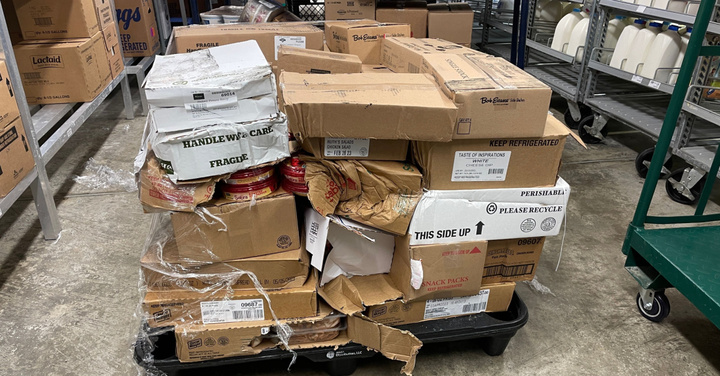What makes shortage and concealed damage freight claims so challenging is they occur after the driver has left, essentially becoming a “he said/she said” between the carrier and the consignee. While many shipments arrive safely and securely, it’s crucial to have a plan of action and a clear understanding of the steps to take in the event of hidden problems. Identifying concealed damage and shortage, documenting it, and filing claims quickly can help to minimize the negative impact on time, resources, and customer satisfaction.
This guide will dive into the best practices for detecting and dealing with concealed damage or shortages, explore the legal aspects surrounding these issues, and look at prevention strategies. Whether you are a shipper, consignee, or logistics professional, our guide will provide valuable resources and practical advice to concealed damage freight claims.
Identifying Concealed Damage or Shortage
If the shipment appears in good condition outside, it may still contain concealed damage or shortage. The U.S. General Services Administration (GSA) defines shortage as only part of the shipment arriving, and concealed damage is damage discovered after the delivery driver has left.
Some common indicators of concealed damage include stains or leakage marks on boxes, rewrapped or re-stacked pallets, retaped boxes, broken pallets, incorrect piece count, and holes in boxes. These signs may indicate that the shipment has been mishandled or tampered with during transport, leading to damage or loss.
Filing a Claim for Concealed Damage or Shortage
When concealed damage or shortage is discovered, it’s essential to take immediate action by documenting the damage with the carrier and filing a claim as soon as possible. Keep detailed records of the shipment, including any evidence of inspections made upon delivery, and take pictures. Shippers and consignees can increase their chances of filing a successful concealed damage claim by taking the following steps:
- Document the damage: Document any suspected damage as soon as you find it, taking photos and descriptions of the condition of the packaging.
- Report the damage promptly: Do not hesitate to report the damage or shortage, as delaying the claim can lead to further complications.Contact the carrier without hesitation, making a note of the representative’s name, the date, and the time of your call to avoid any potential complications.
- Submit the claim within the given timeframe: There is a limited window of time for filing a claim, which varies among carriers, but for most carriers, it is five days.
- Provide necessary documentation: Submit all the required documentation, such as a claim form, original bill of lading, paid freight bill, and proof of the value of the damaged goods.
Keeping all the documents in order and including all the information needed to substantiate the claim is essential to telling the story and proving when the damage occurred. Working with the carrier on the claim and providing all required information can help expedite the claim process and increase the chances of reimbursement.
Preventing Concealed Damage or Shortage
Preventing concealed damage freight claims starts by using proper packaging techniques. The packaging should be sturdy enough to withstand the rigors of transportation and avoid damage. Choosing suitable packaging materials and tried and true processes can reduce concealed damage and freight charges. Choosing a reliable carrier can provide peace of mind for the goods to arrive at their destination safely and securely.
Legal Aspects of Concealed Damage or Shortage
The Carmack Amendment maintains carriers’ liability for cargo damages regardless of cause, making it easier for shippers to file valid freight claims, even when the damage is not readily discernible upon receipt. The amendment sets out the responsibilities of shippers and carriers when goods are damaged, contaminated, delayed, or lost in transit. Carriers may be exempt from damage claims under specific circumstances, such as acts of God.
The Bill of Lading is the contract of carriage required for filing a claim. It outlines specific information about the transported goods, including freight class, NMFC codes, pickup/delivery location, and total weight and piece count. Furthermore, it contains billing details such as the cost and the responsible party, BOL number for tracking, and shipping/order info.
Frequently Asked Questions
How much time do you have to file a claim for concealed damage or shortage?
Under the Carmack Amendment, cargo claims must be filed within nine months from the delivery date (or the anticipated delivery for lost shipments). This nine-month window is the minimum time a carrier must provide for filing a claim. However, claimants only have five days to file concealed damaged claims.
Can concealed damage be claimed if the Delivery Receipt is signed as “received in good condition”?
It is imperative that all customers notate the condition of the goods at the time of delivery on the Delivery Receipt or Proof of Delivery. Despite receiving a delivery receipt signed as “received in good condition,” claimants can still seek compensation for concealed damage or shortage. However, less than 10% of clear POD claims are paid, when damages or shortages are noticed after a clear delivery.
Claimants should file a claim within the specified 5-day timeframe and provide additional evidence to support their claim. However, based on the carrier’s Liability Limitations and Release Value, they might only pay for up to the liability per pound amount if approved.
How can I prove that concealed damage occurred during transit, not before or after?
If goods are packaged appropriately for transit, and their packaging only exhibits typical wear and tear, it becomes tough to trace when, where, or how precisely any damage occurred. Keep evidence of damaged items, packaging, and surrounding material as proof of concealed damage during transit. Proving that concealed damage occurred during transit and not before or after can be challenging. It’s vital to report the damage as soon as possible and not to dispose of any damaged items or packaging until authorized by the carrier or insurance company.
To ensure accuracy, distinguishing between visible and concealed damage is essential. If damage is visible and not concealed, it should have been noted on the delivery receipt at the time of delivery. In such cases, carriers may question how shipment handling after the delivery receipt was signed as clear, making it even more critical to provide accurate documentation and evidence.
Rely on Freightclaims.com for Concealed Damaged and Shortage Claims
Concealed damage or shortage during shipping can be a frustrating experience for both shippers and consignees. However, even with preventative measures, it’s still possible for concealed damage or shortage to happen. You want to be vigilant during inspections, use proper packaging techniques, and work with reliable carriers to prevent these issues from occurring. At Freightclaims.com, we make reimbursement a breeze, making it easier to complete the freight claims process accurately and quickly. Our platform allows you to file a claim online and track the claim’s progress in real time.


